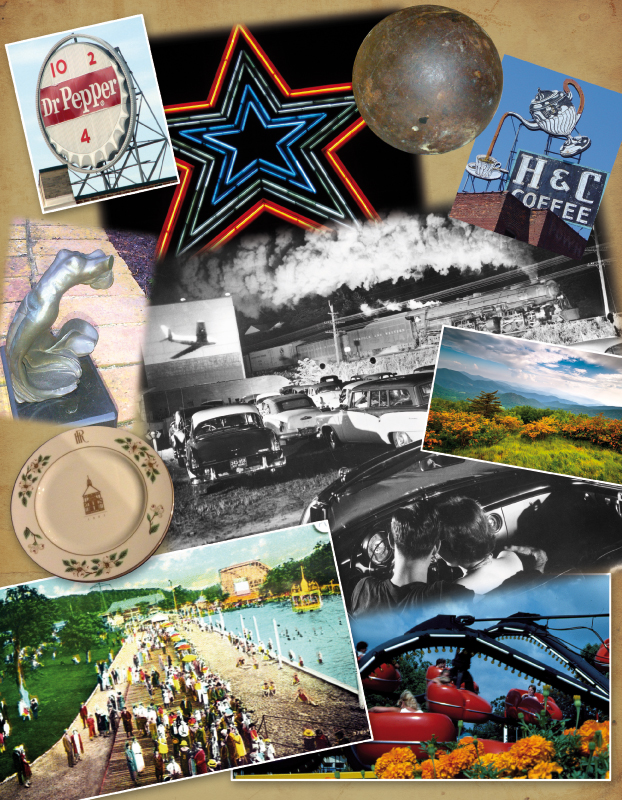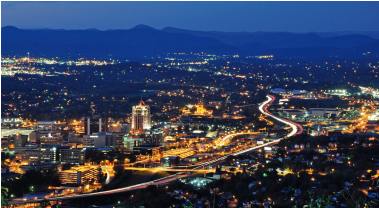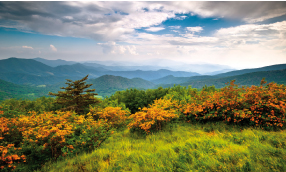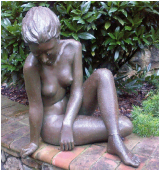Treasure Hunting: Local Collectibles and How to Find Them

 Where are Roanoke’s treasures? When I was asked to write a feature for Roanoke Valley HOME on this topic, I went to the source. I consulted with people in the know, the people who have lived lifetimes in Roanoke and recognize what locals look for and cherish.
Where are Roanoke’s treasures? When I was asked to write a feature for Roanoke Valley HOME on this topic, I went to the source. I consulted with people in the know, the people who have lived lifetimes in Roanoke and recognize what locals look for and cherish.
I talked to business owners, art dealers, antique collectors, designers, longtime home owners and politicians. When I asked them what Roanoke citizens consider important and what represents their city, replies were comparable. Everyone agreed about what is significant and memorable in this town. It all harkens back to an event, a person, a place or an industry that is or was part of Roanoke.
When the Virginia & Tennessee Railroad came to the little community known as Big Lick in the 1850s and laid its tracks, it was the beginning of a new era for the region. The farming community became a railroad town with a growing downtown area. Big Lick blossomed into a manufacturing hub and distribution center for tobacco, lumber and other supplies.
When the Virginia & Tennessee Railroad was purchased by Norfolk & Western, the new owners decided to connect the two lines in Big Lick. By 1884 the population swelled as people moved in for railroad jobs and peripheral support services. Big Lick was granted a city charter and was renamed Roanoke.
Any memento of the railroad, which played such an important role in Roanoke’s success as a city, became a cherished keepsake. And the two local museums that help interpret its history are gems. Roanoke is proud to claim them as its own.
 The O. Winston Link Museum offers a glimmer of Roanoke’s railroad past. Located directly across from the Hotel Roanoke on Shenandoah Avenue, the original passenger rail station was converted in 2004 into a museum devoted to the photography of O. Winston Link. Link was nationally known for his images on 4×5 film using a Graphic View Camera and his photographs of steam locomotives, often taken after dark, captured the vanishing days of the steam locomotive.
The O. Winston Link Museum offers a glimmer of Roanoke’s railroad past. Located directly across from the Hotel Roanoke on Shenandoah Avenue, the original passenger rail station was converted in 2004 into a museum devoted to the photography of O. Winston Link. Link was nationally known for his images on 4×5 film using a Graphic View Camera and his photographs of steam locomotives, often taken after dark, captured the vanishing days of the steam locomotive.
The Virginia Museum of Transportation, located on the tracks of Norfolk & Southern on Norfolk Avenue, also tells the story of Roanoke’s rich railroad heritage. Collections of large diesel locomotives, rail cars, and automotive, transit and other transportation artifacts are displayed, preserving a slice of Virginia’s transportation history.
Each of these sites encourages visitors to learn more about the railroad and collect its memorabilia. The superb black and white prints of O. Winston Link grace many local homes. Children and adult collectors prize replicas of Norfolk & Western trains. What child does not enjoy setting up model trains, imagining the life and adventures along the rails?
The “Grand Old Lady” overlooking downtown is a true treasure to Roanoke. Built in 1882, the Hotel Roanoke was constructed for tired and soot-covered railroad travelers who disembarked from the nearby station, and found comfort and the finer amenities after traveling on the train. It was considered ‘the’ hotel back then and has continued to play host to tourists, corporate leaders, celebrities and dignitaries.
When Norfolk & Western merged with Southern to form Norfolk & Southern Railway, the Corporation was not interested in operating a hotel. They donated the facility to Virginia Tech. In the late 1980s there was a sale of all of its contents. Local citizens flocked to the sale to purchase everything from fine china and silverware to fixtures and furniture. Many of these pieces have found their way into Roanoke homes where they add the grace and charm of yesteryear and remind us of what a grand old lady Hotel Roanoke was and continues to be within the community.
“My favorite places in the whole world are the Star and Disneyworld!” stated one young Roanoke resident. In 1949, on Thanksgiving eve, Roanoke’s Star on Mill Mountain was lit for the first time. Located on the northern portion of the summit 1,045 feet above the city, the Star was initially erected as an attraction to encourage Christmas shoppers to come to town. The Roanoke Merchants Association funded it and once they witnessed the Star’s popularity the decision was made to keep the 88.5-foot landmark lit year-round. Visible within a twenty- mile radius of the city, it is the source of Roanoke’s nickname, ‘The Star City.’ A view of the Star is a cherished sight.
Directly in front of the Star is a dramatic overlook with views of downtown Roanoke and the valley beyond. The overlook connects directly with the Blue Ridge Parkway which is well- known for its beautiful scenery. The Parkway was a product of the New Deal and its efforts to provide jobs for the unemployed of the Great Depression. Construction began in 1935, and the road twisted and twined through the Blue Ridge Mountains thus creating a link between Shenandoah National Park and the Great Smokies. With literally a view at every turn, the opportunity for photography is everywhere no matter what the season.
Roanoke homes offer a commanding view of the Star, the mountains and the surrounding countryside. Builders often try to locate homes on lots just for their views. Tinker Cliffs and McAfee’s Knob, both of which are accessible at trailheads in the Roanoke Valley, offer spectacular scenery. McAfee’s Knob is one of the most photographed spots in the area and its overhang is prevalent on Virginia license plates, postcards, paintings and posters. McAfee’s Knob offers a 270-degree panorama of Catawba Valley and North Mountain to the west, Tinker Cliffs to the north and the Roanoke Valley to the east. The views and rock outcroppings along Tinker Cliffs are worth the effort of ascent and provide wonderful vantage points for photography and other artistic opportunities.
 Nothing could be more breathtaking than our local wildflowers when in full bloom. One of the foremost in this collection is the delicate and outlandishly-bright flame azalea. There is no better place to see the flame azalea than along the Blue Ridge Parkway, and the Roanoke Valley claims to have some of the largest around. Most gardeners agree that it is one of the showiest of our local shrubs with its yellow and bright orange flower clusters. Because it is such a crowd pleaser, nurseries have domesticated the plant and it is now widely available for purchase. Both low-maintenance and fast-growing, the flame azalea is known for its heavy blooms and spectacular color variation. In this instance we can enjoy a Roanoke treasure right in our own backyard.
Nothing could be more breathtaking than our local wildflowers when in full bloom. One of the foremost in this collection is the delicate and outlandishly-bright flame azalea. There is no better place to see the flame azalea than along the Blue Ridge Parkway, and the Roanoke Valley claims to have some of the largest around. Most gardeners agree that it is one of the showiest of our local shrubs with its yellow and bright orange flower clusters. Because it is such a crowd pleaser, nurseries have domesticated the plant and it is now widely available for purchase. Both low-maintenance and fast-growing, the flame azalea is known for its heavy blooms and spectacular color variation. In this instance we can enjoy a Roanoke treasure right in our own backyard.
As much a part of Roanoke as the Roanoke Star are the neon H&C Coffee sign and the Dr. Pepper sign, visible in downtown Roanoke. The animated H&C sign appears as if coffee is pouring out of the tipped spout and the Dr. Pepper sign depicts a giant bottle cap with the numbers 10, 2 and 4 and the Dr. Pepper logo emblazoned on top. The sign reminds us that a Dr. Pepper is good all day long, at 10AM, 2PM, or 4PM. Supposedly Dr. Pepper sold more bottles in the Roanoke Valley than any other metro area east of the Mississippi River, and Roanoke became known as the Dr. Pepper Capital of the World, breaking world records for consumption in the 1950s. Old Dr. Pepper bottles are highly desirable as are prints of the city skyline with the H&C Coffee sign and Dr. Pepper sign in a prominent place.
When the Hotel Roanoke reopened after its restoration, it added the Market Square Walkway that connects visitors to the hotel with the downtown market via a pedestrian’s bridge. In the early 1980s the market area had dramatically declined, but the city market district has experienced a rebirth over the past twenty-five years. It has risen from being one of crime and derelict buildings to a showcase with museums, galleries, restaurants and small shops. The centerpiece of the downtown area is the Historic Farmers’ Market. Established in 1882, it is Virginia’s oldest open-air farmers’ market in continuous operation. Shoppers can purchase plants and fresh local herbs and produce in season. Craftsman and artists display their wares in booths, and homemade delicacies are available for purchase. It is a scenic spot and is often the subject of paintings and photographs.
While it is no longer in existence, memories of Lakeside Amusement Park are vivid for many who lived in the Roanoke Valley. Opened in the 1920s, it featured an enormous swimming pool, complete with a sandy beach, amusement rides, a carousel and a roller coaster named the Shooting Star. Its owner was a controversial businessman who was known to restrict the use of his facilities based on race and religion. When revenues and attendance declined in the early 1980s, the park was closed. Today locals still value old postcards and photographs that depict some of the popular rides at the park such as the Twirl-Around Ferris Wheel and the Lindy Planes.
The Civil War played a prominent role in the history of the Valley, so it is not surprising that Roanoke collectors clamor for Civil War memorabilia. Union General David Hunter marched southward to drive out the Confederate forces throughout the Shenandoah Valley. In 1864 Hunter’s Raid served as a prelude to the Battle of Hanging Rock where General Hunter was driven to retreat. Be it guns from that era, uniforms, old photographs or even cannonballs, collectors relish finding items from this period in local shops and estate sales.
The many talented citizens of Roanoke are among the greatest of its treasures. The quality of art and high caliber of the artists are evident. Many homes in the area play host to wonderful art created by both painters and sculptors. Galleries and private studios abound where locals and visitors can witness artists at work and even purchase their finished pieces.
Some of these artists are no longer living but their art can be found on display and even for sale. American illustrator and portrait painter Walter Joseph Biggs grew up in Salem. He studied at the prestigious New York School of Art and became one of the foremost illustrators of his time. Another illustrator of this era was George Solonevich. He was the son of an anti-communist political writer and was born in Russia at the beginning of the Russian Revolution. He escaped his country and settled in Roanoke where he kept a studio. He was known for his paintings expressing political commentary as well as works depicting exotic animals, dinosaurs and views of outer space.
 Betty Branch is recognized internationally as a sculptor and painter. Her thirty-plus-year career focuses on the female form in a variety of media including bronze, stone, fiber and even straw. She continues to work in her studio in downtown Roanoke and her work is treasured and displayed in corporate headquarters, homes and museums.
Betty Branch is recognized internationally as a sculptor and painter. Her thirty-plus-year career focuses on the female form in a variety of media including bronze, stone, fiber and even straw. She continues to work in her studio in downtown Roanoke and her work is treasured and displayed in corporate headquarters, homes and museums.
A list of Roanoke gems and treasured things would not be complete without including artists Eric Fitzpatrick and Greg Osterhaus. Both have local studios where they work and exhibit their art. Erik Fitzpatrick’s technique is Expressionistic and full of emotion while Greg Osterhaus’ art focuses on pastoral views of the Virginia countryside. He is probably most famous for his cows.
Roanokers are a proud people. They recognize their roots and understand what makes the Roanoke Valley such a special place and what makes their city tick. Roanoke art, history and its incredible natural features – these are the treasures that identify the city as Roanoke.






